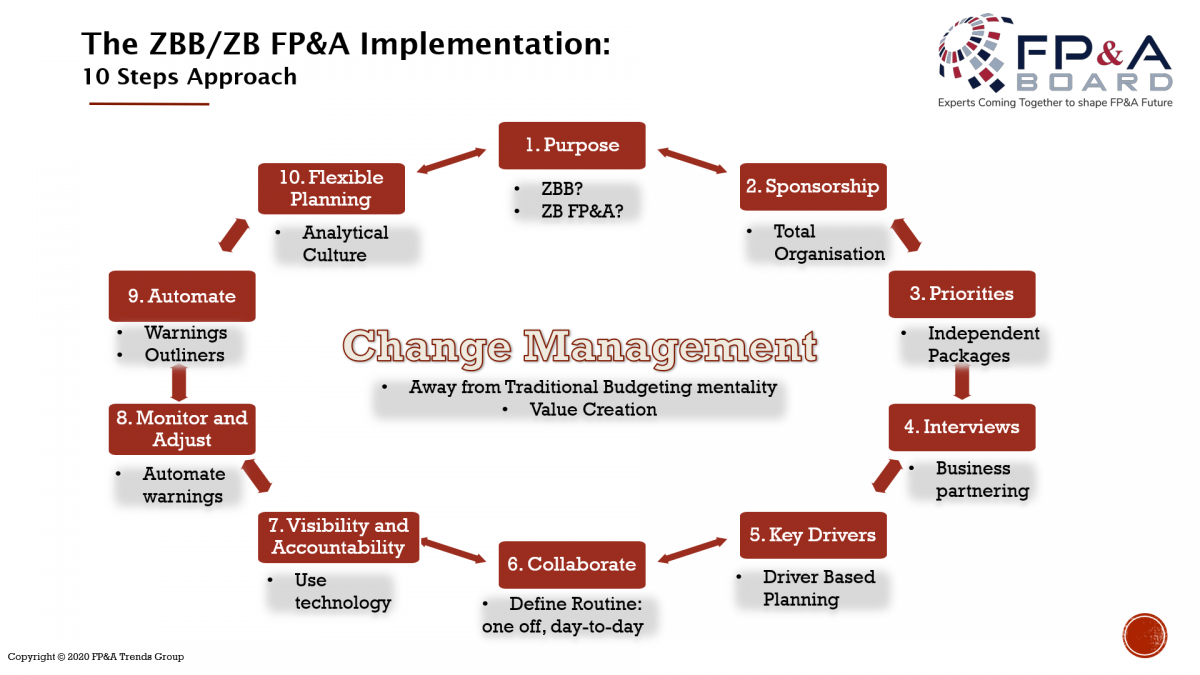In this article, we will explore the concepts of Zero-Based Budgeting and Zero-Based FP&A. The word...
 The subject of Zero-Based Budgeting (ZBB) and Zero-Based Financial Planning & Analysis (ZB FP&A) has been debated in 11 chapters of the International FP&A Board around the globe. Consequently, we concluded how the process should be implemented.
The subject of Zero-Based Budgeting (ZBB) and Zero-Based Financial Planning & Analysis (ZB FP&A) has been debated in 11 chapters of the International FP&A Board around the globe. Consequently, we concluded how the process should be implemented.
It is important to remember that there are no ready-made recipes since every organisation has its own requirements for the ZBB and Zero-Based FP&A design. Nevertheless, the following top 10 practical steps should be taken into consideration:

1. Identify the purpose of the ZBB / FP&A exercise
- Is it just a cost management (ZBB) process?
- Would you like to improve the flexibility of the planning process as a whole?
- Could the Zero-Based approach be applied to expense items only or any other items of P&L, Balance Sheet, and Cash Flow?
2. Sponsorship from the top is essential
- This is not just a finance exercise; it relates to the entire organisation.
- It should be managed top-down and supported bottom-up.
3. Prioritise the items to be investigated and rank them within that list
- Key stakeholders need to determine. Which planning items would benefit from this exercise?
- The reviewed items should be relatively independent of others to be the subject of the Zero-Based review.
- Typically, this approach works well for the so-called “independent decision packages”, e.g. for top cost centres, some revenue-related items, and to relevant reserves in the Balance Sheet that need a fresh analytical look away from the historical view.
- Additionally, some independent Cash Flow items may also benefit from the Zero-Based approach.
4. Interview key stakeholders - owners of the high-ranking “decision packages”
- Come prepared, having done some analytical work. Try to understand the key drivers before interviewing the stakeholders.
- Remember that the primary purpose of this exercise is to remove bias and unnecessary historic allowances.
- This concept of ZBB and ZB FP&A could be unfamiliar to your non-finance stakeholders. Moreover, they may feel threatened by the prospect of losing their traditional budgeting allowances and are resistant to this necessary change. Therefore, education is as important as change management techniques.
5. Identify Key Business Drivers
- Driver Based planning models should be created for all relevant independent items.
- It is important to remember that Zero-Based techniques are great enablers of Driver Based Planning (DBP).
- However, these techniques are not the only ones that are used for the identification of drivers. Working hand in hand with analytical approaches, ZB FP&A can significantly enhance the DBP process.
6. Create a consistent and collaborative ZB FP&A routine if you wish to continue this exercise regularly
- Some organisations prefer doing ZBB/ZB FP&A as a one-off exercise; to remove inefficiencies and to understand the key drivers.
- Like Kraft Heinz Company, others choose to incorporate the ZBB method into their day-to-day operations and treat it as an important continuous process.
- Both approaches (one-off or continuous) are acceptable and work well in combination with other budgeting and planning techniques.
- Collaboration through flexible systems that allow easy integration of different Zero-Based Packages plays a vital role in the ZB FP&A routine.
7. Create Visibility and Accountability
- According to recent research by Deloitte, “poorly designed tracking and reporting” was a critical factor in the failure of ZBB in 43% of cases.
- Visibility is easily obtained through modern collaborative systems.
- Unfortunately, the traditional Excel setup would be problematic with both Visibility and Accountability. This is one of the reasons why the process is not value-adding.
8. Monitor the Variances and Adjust the Drivers
- This ongoing process should be managed appropriately.
- Technology can help with checking sensitivities.
9. Automate the process as much as possible
- Modern technologies can simplify the ongoing routine.
- They can create a system of automatic “Warnings”, “Outliners”, and “Actions”.
10. Create Analytical Culture
- Move away from traditional budgeting to a flexible and dynamic planning process.
- Driver Based approach allows for quick re-forecasting and easy on-demand scenario planning.
All the above steps require the deployment of Change Management techniques. If traditional budgeting mindsets are still prevalent in your organisation, there will be resistance to change.
ZB FP&A: Key Success Factors from International FP&A Board
ZBB is not just a cost-cutting tool. It is a broader concept that can be applied to more than just cost bases. Using a blend of Driver based and Zero-Based techniques can help with transforming the entire FP&A process. This is why we call it Zero-Based FP&A (ZB FP&A)
Plan for ZBB and ZB FP&A Success:
- Understand the culture vs strategy gap – buy-in and support from the top are essential.
- Know your Key Drivers – Make sure you completely understand what the primary drivers are for your business/project/situation.
- Distinguish between Drivers and Relationships – sometimes, the true driver can be hidden.
- Build values that count – Create Business partnering models that work.
- Standardisation and visibility of the reviewed items is the first foundation of effective ZBB and ZB FP&A.
- The organisation needs to be structured to drive savings from ZBB through ‘dual accountability’. Cost or Profit centre owners oversee their items and will often control several reviewed categories. Package owners will look at the total spend for that package across the whole business, and they are incentivised to achieve efficiencies.
- Have the right vehicle, prepare the right tools for the process, and continue building and refining.
- Centralise where possible: Only ask the business to forecast what it can control – reduce time and increase the effectiveness of budget input.
- Who is truly accountable and can make a difference? Educate, challenge and control the process and empower key stakeholders.
- Business partners need to understand the interdependence that managers in siloes can’t see.
- Be clear about the future: How will this help, and what are you going to give back? What is the incentive?
Key Conclusions and Recommendations
The below conclusions and recommendations were adjusted from the insights that were generated at the London FP&A Circle.
Conclusions
- ZB FP&A is being driven in part by technology. The process is much faster as we have greater analysis and insights into the FP&A items. We can also now facilitate the workflows without the limitations of spreadsheets.
- ZB FP&A still requires focusing on culture and a mindset shift. A survey of blockers by Accenture found that 61% cited culture, and 40% cited change management. When talking about ZB FP&A, don’t talk about resource reduction; talk about value creation. ZB FP&A should be seen as reallocating cash to fuel growth, not a drastic spend reduction exercise.
- ZB FP&A ownership and governance is a key driver of sustainability. Dual ownership of forecasted items (e.g. on an operational and a corporate level) is powerful and one of the tools that continue to challenge costs and drive efficiencies in the long run.
Recommendations
- Focus on sustainability. You need to win the hearts and minds, creating an ‘ownership’ mindset amongst employees.
- Position this as a way to fuel growth and simplify the organisation, not just as a resource reduction exercise.
- ZB FP&A is a tough process for employees, so you must strive to engage them as early as possible. Do not forget about rigorous Change Management techniques.
- In addition to bottom-up employee engagement, it requires top-level sponsorship and visibility.
Subscribe to
FP&A Trends Digest

We will regularly update you on the latest trends and developments in FP&A. Take the opportunity to have articles written by finance thought leaders delivered directly to your inbox; watch compelling webinars; connect with like-minded professionals; and become a part of our global community.




